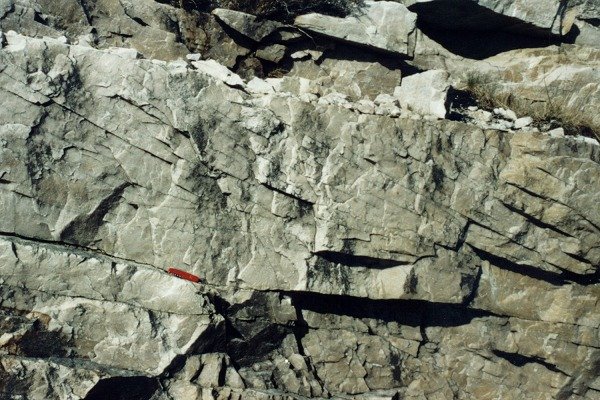
| Home | Geological History | Stratigraphy | Area map | Rock Index | About |
| Scourie | Achmelvich | Laxford | Clachtoll | Stoer | Assynt | Skiag Bridge | Glencoul | Knockan | Borralan | Ledmore |
From road-cuts near Skiag Bridge, Loch Assynt

![]() Quartz sandstone; Cambrian basal quartzite, Loch Assynt
Quartz sandstone; Cambrian basal quartzite, Loch Assynt
This is a road-cut outcrop of hard, white Cambrian
quartzite. The penknife is 9 cm long. Notice that there are
two sets of bedding planes visible in the outcrop. There
are prominent straight bedding planes spaced a few tens of
centimetres apart, parallel to the knife and to the row of
loose stones balanced on the ledge at the top. Between
these are curved, more closely spaced, steeper planes,
clearly seen in the unit above the penknife. The tops of
these planes are cut off by the next thick layer. This
structure is called cross bedding, and it is a
common feature of many types of sandstones. In this case,
the clean quartz sand was deposited as sand banks and
shoals near the shore, and the cross beds represent the
sloping sides of the sand bars against which the sand
layers were laid down.
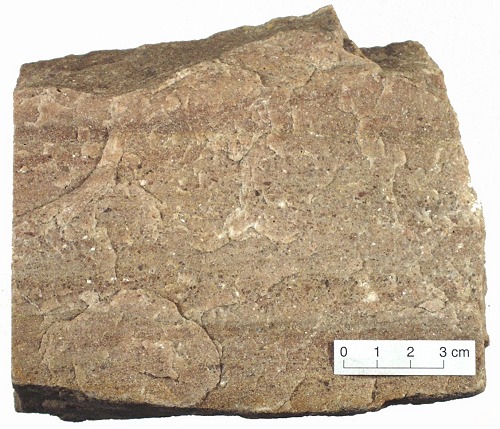
![]() Quartz sandstone; Cambrian basal quartzite, Loch Assynt
Quartz sandstone; Cambrian basal quartzite, Loch Assynt
This is a pure sandstone composed of rounded grains of
quartz, cemented by further quartz between the grains. This
makes the rock very hard and resistant to weathering and
erosion, rather like a metamorphic quartzite formed by the
action of heat and pressure. Even though both grains and
matrix are made of the same material, you can see the
rounded outlines of the sand grains in the hand specimen,
as the original particles were thinly coated with iron
oxide dust. There is a very small number of feldspar
grains, showing up chalky white on the rock surface. In the
pure white varieties of Cambrian quartzite these features
are much more difficult to make out.
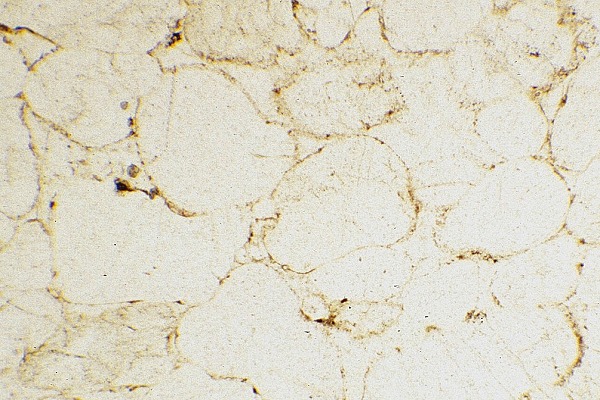
![]() Quartz sandstone; Cambrian basal quartzite,
Loch Assynt
Quartz sandstone; Cambrian basal quartzite,
Loch Assynt
In this pure quartz sandstone, the sand grains are
cemented by quartz that has formed as outgrowths and
overgrowths on the original sand grains. You can see the
rounded outlines of the grains, marked by oxide dust.
Compare this with the view between crossed polars, where
you can see that the rock now consists of tightly
interlocking quartz crystals.
Plane polarized light. Field of view 2 mm across.
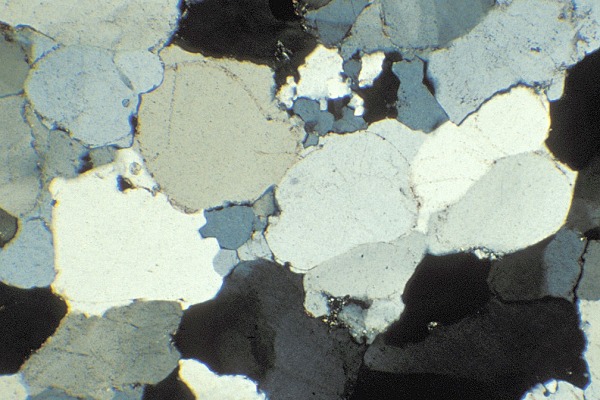
![]() Quartz sandstone; Cambrian basal quartzite,
Loch Assynt
Quartz sandstone; Cambrian basal quartzite,
Loch Assynt
This is a pure quartz sandstone, in which the sand grains
are cemented by quartz that has formed as outgrowths and
overgrowths on the original sand grains. The view under
crossed polars reveals the irregular and interlocking
shapes of the grains of quartz. This texture makes the rock
very hard and strong, rather like a metamorphic quartzite
formed by the action of heat and pressure. Sedimentary
rocks like this, in which the quartz cement formed at low
temperature, are commonly called orthoquartzite. Note that
in places you can see the rounded outlines of the original
sand grains, marked by oxide dust. Compare this with the
view in plane polarized light.
Crossed polars. Field of view 2 mm across.
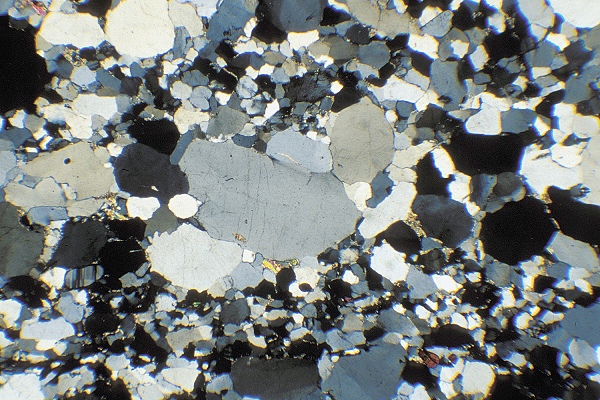
![]() Quartz sandstone; Cambrian basal quartzite,
Loch Assynt
Quartz sandstone; Cambrian basal quartzite,
Loch Assynt
The bedding in the quartzite is commonly outlined by by
bands of differing grain size. Here, alternating layers
about 2 mm thick are composed of quartz-cemented sand
grains averaging about 1 mm and 0.25 mm in diameter.
Crossed polars. Field of view 7 mm across.
| Scourie | Achmelvich | Laxford | Clachtoll | Stoer | Assynt | Skiag Bridge | Glencoul | Knockan | Borralan | Ledmore |
| Home | Geological History | Stratigraphy | Area map | Rock Index | About |
D.J. Waters, Department of Earth Sciences, May 2003